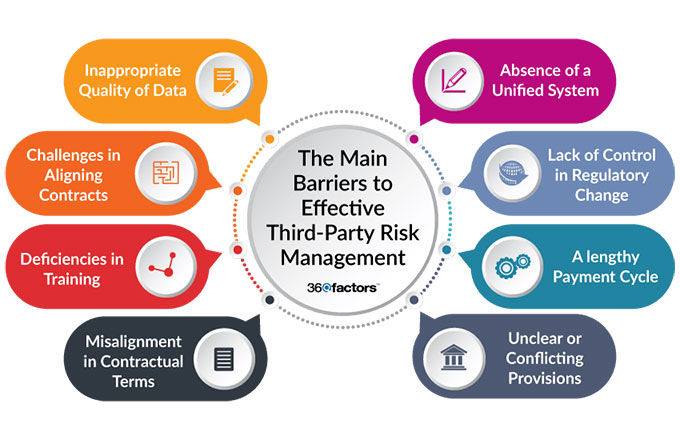Home/ Blog / Unraveling the Barriers to Effective Third-Party Risk Management
Enterprises across various sectors are undoubtedly progressively dependent on third parties to perform their daily operational requirements. Gone are the days when vendor relationships were motivated by cost efficiency solely. In this evolving business landscape, leading organizations are more focused on third parties’ relationships for financial efficiencies and improved organizational scalability, agility, and innovation. In this scenario, effective third-party risk management can significantly enhance business competitiveness by boosting operational efficiency, mitigating legal and financial risks, and building trust with customers and stakeholders.
This transformation in the dynamics of third-party partnerships is reflected in the statistics published by Deloitte in one of their global surveys. It reveals that 73.9% of respondents admit that third parties will play a significant role in the coming years; an increase from the previous year where 60.3% of respondents shared that belief. These facts present the significance of improving and sustaining robust third-party relationships, considering them an essential element of contemporary business strategy.
As dependencies on third parties continue to progress, so do the challenges and complexity of managing vendor relationships. Effective third-party risk management has become essential to ensure these collaborations provide the anticipated value without detecting undue risks or operational setbacks. The barriers range from legal ambiguities to technological mismatches, and the challenges to successful third-party risk management are frequently interconnected.
In this blog, we will unravel these barriers after shedding light on the importance of third-party risk management for business success. Furthermore, we will explore innovative approaches to deal with these challenges.
Why Effective Third-Party Risk Management Is Essential for Business Success
Effective vendor risk management is crucial for business success because it facilitates recognizing, evaluating, and controlling risks related to third parties, vendors, or business partners. In this current highly interconnected business environment, organizations mostly rely on external partners or collaborators for their main functions, such as manufacturing, IT services, and supply chain management.
This element of reliance attracts potential vulnerabilities that can be considered challenges which can turn into legal liabilities, operational disruptions, and reputational damage if not managed appropriately. Effective third-party risk management involves conducting due diligence on latent vendors, monitoring performance consistently, ensuring adherence to regulation compliance, and executing contingency plans for anticipated failures. This comprehensive approach mitigates possible negative influences and improves the efficiency and quality of the services or products provided by third parties. In this current era, where competition is at its peak, a robust vendor risk management system is a risk mitigation tool and a vital component of sustainable business success.
The Main Barriers to Effective Third-Party Risk Management

Absence of a Unified System for Managing Contracts and Templates
Without a holistic system to sustain and manage contracts and templates, financial enterprises often experience difficulties in monitoring and gaining access to essential documents. Existing templates often go unused or must be more consistently applied, leading to inefficiency and potential legal exposure.
A centralized system to maintain and manage contracts and templates allows companies to track and access critical documents easily.
Variability and Lack of Control in Change Management Procedures
The absence of consistent and standardized processes for regulatory change management within effective third-party risk management or vendor relationships can lead to uncontrolled modifications. This inconsistency increases the risk of legal challenges and may cause end-project delays. Ultimately, it breaks the efficiency and effectiveness of third-party collaborations.
Lengthy Payment Cycle Due to Non-Standardized Review of High-Volume Transactions
Managing transactions from various sources without a standardized procedure can lead to inconsistency and delays in payment cycles. This not only consumes financial resources but also complicates associations with partners, which can lead to dissatisfaction or disputes.
Unclear or Conflicting Provisions Within Contractual Agreements
Contracts that contain unclear or conflicting terms lead to confusion or disputes. It is one of the most noticeable challenges that can impact the effective third-party risk management system for a business. This shortcoming can impact the speed of project execution, increase your legal costs and break the trust between organizations. All these elements can drain and put stress on a successful third-party risk management framework.
Inappropriate Quality of Data Provided by Third Parties
The organization’s ability to perform the relevant trend analysis becomes compromised if third parties do not provide accurate, complete, and consistent data. This restriction impacts strategic decision-making, risk prediction, and the business’s ability to deal with potential issues or risks proactively.
Challenges in Aligning Contracts, Vendor Categories, and Expenditure Data
The need for mapping and interconnecting essential third-party risk components can often make it difficult to oversee effective third-party risk management. The complexity in third-party risk management may lead to inefficiencies, hindering the management of third-party expenses and relationships.
Deficiencies in Education and Training Related to Contract Management
Without appropriate training, the officer responsible for vendor risk management can make miss checking for errors, ignore critical details, or fail to implement best practices consistently. This can result in cost overruns, legal exposure, and a general lack of control over third-party engagements.
Misalignment in Interpretation of Contractual Terms Between Company and Vendors
Having the same level of contract interpretation between an organization and its vendor is essential. Any variations in performance expectations can create friction that leads to conflict and partnership challenges. This inconsistency can impact project success and deteriorate long-term third-party risk management relationships within the effective third-party risk management framework.
New Approaches to Address These Barriers
Utilizing Analytics and Technology to Mitigate Payment Cycles
Financial companies can use advanced analytics and technology to streamline and accelerate payment processes, mitigate delays and improve efficiency in financial operations.
Executing a Dedicated Model for Contract Management
A dedicated model for contract management that involves assigning specific personnel, either in-house officers or external experts. These experts can manage and oversee contract terms and invoice mediation to ensure overall effective third-party risk management. This dedicated oversight approach ensures stabilized monitoring, enhanced risk management, and more effective control over vendor engagement.
Continuous Proactive Management of Third-Party Contracts
By proactively implementing continuous checks on third-party contracts, companies can attain significant enhancements in risk management. This hands-on approach enables instant detection and mitigation of problems, leading to increased collaboration and trust with third-party collaborators.
Setting Transparent Expectations and Mitigating Payments Cycles
Clear communication and setting transparent expectations with 3rd party risk management, as it enables a shorter payment cycle, and avoids any risks of overpayments. This approach leads to cost efficiency and builds more effective third-party risk management relationships.
Ensuring Successful Implementation for Positive Return on Investment
When all these approaches are implemented appropriately, it leads to noticeable cost savings for the business. Such savings can be reinvested into the company, producing a positive return on investment and improving the business’s success and sustainability.
Conclusion
Organizations must implement an innovative and proactive approach for effective risk management. An effective third-party risk management approach helps them deal with ever-growing challenges, while mitigating potential risks related to vendors. Integrating AI-based technology for TPRM, such as Predict360 third-party risk management software, offers an opportunity for financial organizations to streamline third party service providers. The platform provides comprehensive visibility into third-party engagement by leveraging automation, analytics, and real-time monitoring.
The Predict360 vendor risk management solution allows financial enterprises to monitor, manage and report risks related to third parties under a holistic platform. The solution allows for an effective third-party risk management lifecycle and monitors vendor performance, issues, metrics, risks, certification, etc. It provides A holistic data repository that gathers information and documents regarding third parties using customized checklists from onboarding to security valuation and periodic supplier performance evaluation to due diligence.
Request a Demo
Complete the form below and our business team will be in touch to schedule a product demo.
By clicking ‘SUBMIT’ you agree to our Privacy Policy.



